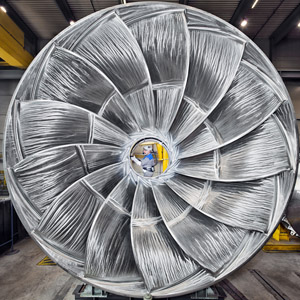HydroVision took place this week in Oregon and during the event, Voith Hydro President and CEO Bob Gallo said that the state provides, “the perfect setting to shine a light on the value of hydropower”. The company has an office in Springfield, Oregon in addition to offices in several other states.
“Oregon is the perfect showcase for hydropower’s past, as well as its future potential,” said Gallo. “Though hydropower accounts for over 50% of Oregon’s power generation, the state has the capacity to double the clean and renewable hydropower it already provides to power its homes and businesses. With the right policies in place, we can truly unleash hydropower’s vast untapped potential, and Voith Hydro has the environmentally-friendly hydropower equipment and technology to power the future.”

Francis-Turbine for the hydro power plant Bratsk, Siberia.
Awarded picture of the year and product image of the year at the German “PR Bild Award 2014”.
Hydroelectric power provides Oregon with half of the state’s power. According to a 2014 Department of Energy New Stream-reach Development report, Oregon could more than double its current 8,000 MW in installed capacity and its potential, finds the report, is greater than any other state. The potential capacity is part of 65,000 MW of available but untapped hydropower across the country.
The same report said the U.S. can develop this potential by powering many of the approximately 80,000 dams that currently do not produce hydroelectric power and spread up the process to hydropower by streamlining an often burdensome and timely licensing process. Congress is currently attempting to build on 2013 legislation that streamlined the process for many small hydropower projects by exploring further regulatory reforms that will reduce inefficiencies and redundancies in the licensing process for projects both large and small. The need, agress Gallo, for timely reform is important given that 250 projects representing 11,000 MW of installed capacity are up for relicensing over the next 10 years.
While hydropower’s direct environmental benefits are immense, explained Gallo, its other attributes are significant. It supports the development of other renewables through baseload power generation, provides for flood control, creates recreational opportunities, and supports irrigation projects. It also creates jobs. By one estimate, with the proper policies in place, hydropower could create 1.4 million cumulative jobs by 2025, on top of the 300,000 jobs already supported by American hydropower.
“Hydropower is a win-win for both the environment and the economy,” Gallo concluded. “Voith Hydro looks forward to continued progress to bring more of America’s largest renewable resource online.”

